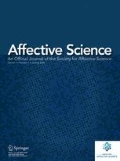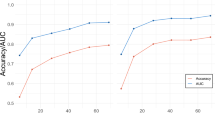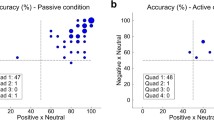Abstract
Hedonic valence describes the pleasantness or unpleasantness of psychological states elicited by stimuli and is conceived as a fundamental building block of emotional experience. Multivariate pattern analysis approaches contribute to the study of valence representation by allowing identification of valence from distributed patterns of activity. However, the issue of construct validity arises in that there is always a possibility that classification results from a single study are driven by factors other than valence, such as the idiosyncrasies of the stimuli. In this work, we identify valence across participants from six different fMRI studies that used auditory, visual, or audiovisual stimuli, thus increasing the likelihood that classification is driven by valence and not by the specifics of the experimental paradigm of a particular study. The studies included a total of 93 participants and differed on stimuli, task, trial duration, number of participants, and scanner parameters. In a leave-one-study-out cross-validation procedure, we trained the classifiers on fMRI data from five studies and predicted valence, positive or negative, for each of the participants in the left-out study. Whole-brain classification demonstrated a reliable distinction between positive and negative valence states (72% accuracy). In a searchlight analysis, the representation of valence was localized to the right postcentral and supramarginal gyri, left superior frontal and middle frontal cortices, and right pregenual anterior cingulate and superior medial frontal cortices. The demonstrated cross-study classification of valence enhances the construct validity and generalizability of the findings from the combined studies.



Similar content being viewed by others
References
Abelson, R. P., & Sermat, V. (1962). Multidimensional scaling of facial expressions. Journal of Experimental Psychology, 63(6), 546–554.
Baker, M. (2016). Reproducibility crisis? Nature, 533(26), 353–366.
Barrett, L. F. (2017). The theory of constructed emotion: An active inference account of interoception and categorization. Social Cognitive and Affective Neuroscience, 12(11), 1833.
Barrett, L. F., & Bliss-Moreau, E. (2009). Affect as a psychological primitive. Advances in Experimental Social Psychology, 41, 167–218.
Baucom, L. B., Wedell, D. H., Wang, J., Blitzer, D. N., & Shinkareva, S. V. (2012). Decoding the neural representation of affective states. Neuroimage, 59(1), 718–727.
Bennett, C. M., & Miller, M. B. (2013). fMRI reliability: Influences of task and experimental design. Cognitive, Affective, & Behavioral Neuroscience, 13(4), 690–702.
Bigand, E., Filipic, S., & Lalitte, P. (2005). The time course of emotional responses to music. Annals of the New York Academy of Sciences, 1060(1), 429–437.
Bowring, A., Maumet, C., & Nichols, T. E. (2019). Exploring the impact of analysis software on task fMRI results. Human Brain Mapping, 40(11), 3362–3384.
Bradley, M. M., & Lang, P. J. (1999). Affective norms for English words (ANEW): Instruction manual and affective ratings: Technical report C-1, the center for research in psychophysiology. University of Florida.
Bradley, M. M., & Lang, P. J. (2000). Affective reactions to acoustic stimuli. Psychophysiology, 37(2), 204–215.
Bradley, M. M., & Lang, P. J. (2007). The International Affective Digitized Sounds (; IADS-2): Affective ratings of sounds and instruction manual. University of Florida, Gainesville, FL, Tech. Rep. B-3.
Bush, L. E. (1973). Individual differences multidimensional scaling of adjectives denoting feelings. Journal of Personality and Social Psychology, 25(1), 50–57.
Bzdok, D., Langner, R., Schilbach, L., Engemann, D. A., Laird, A. R., Fox, P. T., & Eickhoff, S. (2013). Segregation of the human medial prefrontal cortex in social cognition. Frontiers in Human Neuroscience, 7, 232.
Chikazoe, J., Lee, D. H., Kriegeskorte, N., & Anderson, A. K. (2014). Population coding of affect across stimuli, modalities and individuals. Nature Neuroscience, 17(8), 1114–1122.
Costafreda, S. G., Khanna, A., Mourao-Miranda, J., & Fu, C. H. (2009). Neural correlates of sad faces predict clinical remission to cognitive behavioural therapy in depression. Neuroreport, 20(7), 637–641.
Damasio, A. R. (1996). The somatic marker hypothesis and the possible functions of the prefrontal cortex. Philosophical Transactions of the Royal Society of London. Series B: Biological Sciences, 351(1346), 1413–1420.
Dixon, M. L., Thiruchselvam, R., Todd, R., & Christoff, K. (2017). Emotion and the prefrontal cortex: An integrative review. Psychological Bulletin, 143(10), 1033–1081.
Egner, T., Etkin, A., Gale, S., & Hirsch, J. (2007). Dissociable neural systems resolve conflict from emotional versus nonemotional distracters. Cerebral Cortex, 18(6), 1475–1484.
Etkin, A., Egner, T., & Kalisch, R. (2011). Emotional processing in anterior cingulate and medial prefrontal cortex. Trends in Cognitive Sciences, 15(2), 85–93.
Etkin, A., Egner, T., Peraza, D. M., Kandel, E. R., & Hirsch, J. (2006). Resolving emotional conflict: A role for the rostral anterior cingulate cortex in modulating activity in the amygdala. Neuron, 51(6), 871–882.
Gabrieli, J. D., Ghosh, S. S., & Whitfield-Gabrieli, S. (2015). Prediction as a humanitarian and pragmatic contribution from human cognitive neuroscience. Neuron, 85(1), 11–26.
Gao, C., Weber, C. E., & Shinkareva, S. V. (2019). The brain basis of audiovisual affective processing: Evidence from a coordinate-based activation likelihood estimation meta-analysis. Cortex., 120, 66–77.
Gao, C., Weber, C. E., Wedell, D. H., & Shinkareva, S. V. (2020). An fMRI study of affective congruence across visual and auditory modalities. Journal of Cognitive Neuroscience, 32(7), 1251–1262.
Gao, C., Wedell, D. H., Green, J. J., Jia, X., Mao, X., Guo, C., & Shinkareva, S. V. (2018). Temporal dynamics of audiovisual affective processing. Biological Psychology, 139, 59–72.
Gao, C., Wedell, D. H., Kim, J., Weber, C. E., & Shinkareva, S. V. (2018). Modelling audiovisual integration of affect from videos and music. Cognition and Emotion, 32(3), 516–529.
Habes, I., Krall, S. C., Johnston, S., Yuen, K., Healy, D., Goebel, R., et al. (2013). Pattern classification of valence in depression. NeuroImage: clinical, 2, 675–683.
Hayes, W. M., & Wedell, D. H. (2020). Modeling the role of feelings in the Iowa Gambling Task. Decision, 7(1), 67–89.
Just, M. A., Pan, L., Cherkassky, V. L., McMakin, D. L., Cha, C., Nock, M. K., & Brent, D. (2017). Machine learning of neural representations of suicide and emotion concepts identifies suicidal youth. Nature Human Behaviour, 1(12), 911–919.
Kay, K., Rokem, A., Winawer, J., Dougherty, R., & Wandell, B. (2013). GLMdenoise: A fast, automated technique for denoising task-based fMRI data. Frontiers in Neuroscience, 7, 247.
Kim, J., Shinkareva, S. V., & Wedell, D. H. (2017). Representations of modality-general valence for videos and music derived from fMRI data. NeuroImage, 148, 42–54.
Kim, J., Wang, J., Wedell, D. H., & Shinkareva, S. V. (2016). Identifying core affect in individuals from fMRI responses to dynamic naturalistic audiovisual stimuli. PLoS One, 11(9), e0161589.
Kim, J., Weber, C. E., Gao, C., Schulteis, S., Wedell, D. H., & Shinkareva, S. V. (2020). A study in affect: Predicting valence from fMRI data. Neuropsychologia, 107473.
Klasen, M., Kenworthy, C. A., Mathiak, K. A., Kircher, T. T., & Mathiak, K. (2011). Supramodal representation of emotions. The Journal of Neuroscience, 31(38), 13635–13643. https://doi.org/10.1523/jneurosci.2833-11.2011.
Kragel, P. A., Kano, M., Van Oudenhove, L., Ly, H. G., Dupont, P., Rubio, A., et al. (2018). Generalizable representations of pain, cognitive control, and negative emotion in medial frontal cortex. Nature Neuroscience, 21(2), 283–289. https://doi.org/10.1038/s41593-017-0051-7.
Kragel, P. A., & LaBar, K. S. (2016). Decoding the nature of emotion in the brain. Trends in Cognitive Sciences, 20(6), 444–455.
Kreifelts, B., Ethofer, T., Grodd, W., Erb, M., & Wildgruber, D. (2007). Audiovisual integration of emotional signals in voice and face: An event-related fMRI study. Neuroimage, 37(4), 1445–1456.
Kriegeskorte, N., Goebel, R., & Bandettini, P. (2006). Information-based functional brain mapping. Proceedings of the National Academy of Sciences, 103(10), 3863–3868.
Kulkarni, B., Bentley, D. E., Elliott, R., Youell, P., & Jones, A. K. P. (2005). Attention to pain localization and unpleasantness discriminates the functions of the medial and lateral pain systems. European Journal of Neuroscience, 21(11), 3133–3142.
Lang, P. J. (1995). The emotion probe: Studies of motivation and attention. American Psychologist, 50(5), 372–385.
Lang, P. J. (2005). International Affective Picture System (IAPS): Affective ratings of pictures and instruction manual. Technical Report.
Lepping, R. J., Atchley, R. A., Chrysikou, E., Martin, L. E., Clair, A. A., Ingram, R. E., Simmons, W. K., & Savage, C. R. (2016). Neural processing of emotional musical and nonmusical stimuli in depression. PLoS One, 11(6), e0156859.
Li, B. J., Bailenson, J. N., Pines, A., Greenleaf, W. J., & Williams, L. M. (2017). A public database of immersive VR videos with corresponding ratings of arousal, valence, and correlations between head movements and self report measures. Frontiers in Psychology, 8, 2116.
Lindquist, K. A., Satpute, A. B., Wager, T. D., Weber, J., & Barrett, L. F. (2015). The brain basis of positive and negative affect: Evidence from a meta-analysis of the human neuroimaging literature. Cerebral Cortex, 26(5), 1910–1922.
Marusak, H., Thomason, M., Peters, C., Zundel, C., Elrahal, F., & Rabinak, C. (2016). You say ‘prefrontal cortex’and I say ‘anterior cingulate’: Meta-analysis of spatial overlap in amygdala-to-prefrontal connectivity and internalizing symptomology. Translational Psychiatry, 6(11), e944–e944.
Miskovic, V., & Anderson, A. (2018). Modality general and modality specific coding of hedonic valence. Current Opinion in Behavioral Sciences, 19, 91–97.
Munafò, M. R., Nosek, B. A., Bishop, D. V., Button, K. S., Chambers, C. D., Du Sert, N. P., et al. (2017). A manifesto for reproducible science. Nature Human Behaviour, 1(1), 1–9.
Niedenthal, P. M. (2007). Embodying emotion. science, 316(5827), 1002–1005.
Olofsson, J. K., Nordin, S., Sequeira, H., & Polich, J. (2008). Affective picture processing: An integrative review of ERP findings. Biological Psychology, 77(3), 247–265.
Ontivero-Ortega, M., Lage-Castellanos, A., Valente, G., Goebel, R., & Valdes-Sosa, M. (2017). Fast Gaussian Naïve Bayes for searchlight classification analysis. Neuroimage, 163, 471–479.
Peelen, M. V., Atkinson, A. P., & Vuilleumier, P. (2010). Supramodal representations of perceived emotions in the human brain. Journal of Neuroscience, 30(30), 10127–10134.
Pereira, F., & Botvinick, M. (2011). Information mapping with pattern classifiers: A comparative study. Neuroimage, 56(2), 476–496.
Pereira, F., Mitchell, T., & Botvinick, M. (2009). Machine learning classifiers and fMRI: A tutorial overview. Neuroimage, 45(1), S199–S209.
Poldrack, R. A., Baker, C. I., Durnez, J., Gorgolewski, K. J., Matthews, P. M., Munafò, M. R., Nichols, T. E., Poline, J. B., Vul, E., & Yarkoni, T. (2017). Scanning the horizon: Towards transparent and reproducible neuroimaging research. Nature Reviews Neuroscience, 18(2), 115–126.
Poldrack, R. A., Halchenko, Y. O., & Hanson, S. J. (2009). Decoding the large-scale structure of brain function by classifying mental states across individuals. Psychological Science, 20(11), 1364–1372.
Poldrack, R. A., Huckins, G., & Varoquaux, G. (2020). Establishment of best practices for evidence for prediction: A review. JAMA Psychiatry, 77(5), 534–540.
Raizada, R. D., & Lee, Y.-S. (2013). Smoothness without smoothing: Why Gaussian naive Bayes is not naive for multi-subject searchlight studies. PLoS One, 8(7), e69566.
Roberts, J. S., & Wedell, D. H. (1994). Context effects on similarity judgments of multidimensional stimuli: Inferring the structure of the emotion space. Journal of Experimental Social Psychology, 30, 1–38.
Russell, J. A. (2003). Core affect and the psychological construction of emotion. Psychological Review, 110(1), 145–172.
Russell, J. A., & Bullock, M. (1985). Multidimensional scaling of emotional facial expressions: Similarity from preschoolers to adults. Journal of Personality and Social Psychology, 48(5), 1290–1298.
Satpute, A. B., & Lindquist, K. A. (2019). The default mode network’s role in discrete emotion. Trends in Cognitive Sciences, 23(10), 851–864.
Shackman, A. J., Salomons, T. V., Slagter, H. A., Fox, A. S., Winter, J. J., & Davidson, R. J. (2011). The integration of negative affect, pain and cognitive control in the cingulate cortex. Nature Reviews Neuroscience, 12(3), 154–167.
Sharot, T., & Garrett, N. (2016). Forming beliefs: Why valence matters. Trends in Cognitive Sciences, 20(1), 25–33.
Shinkareva, S. V., Wang, J., Kim, J., Facciani, M. J., Baucom, L. B., & Wedell, D. H. (2014). Representations of modality-specific affective processing for visual and auditory stimuli derived from functional magnetic resonance imaging data. Human Brain Mapping, 35(7), 3558–3568.
Skerry, A. E., & Saxe, R. (2014). A common neural code for perceived and inferred emotion. Journal of Neuroscience, 34(48), 15997–16008.
Todd, M. T., Nystrom, L. E., & Cohen, J. D. (2013). Confounds in multivariate pattern analysis: Theory and rule representation case study. Neuroimage, 77, 157–165.
Wang, Q., Cagna, B., Chaminade, T., & Takerkart, S. (2020). Inter-subject pattern analysis: A straightforward and powerful scheme for group-level MVPA. NeuroImage, 204, 116205.
Weber, C. E., Shinkareva, S. V., Kim, J., Gao, C., & Wedell, D. H. (2020). Evaluative conditioning of affective valence. Social Cognition, 38(2), 97–118.
Yuen, K. S., Johnston, S. J., De Martino, F., Sorger, B., Formisano, E., Linden, D. E., & Goebel, R. (2012). Pattern classification predicts individuals’ responses to affective stimuli. Translational Neuroscience, 3(3), 278–287.
Author information
Authors and Affiliations
Corresponding author
Ethics declarations
Funding
This study was funded in part by the College of Arts and Sciences Faculty Research Initiative at the University of South Carolina.
Data Availability
Conflict of Interest
The authors declare that they have no conflict of interest.
Ethics Approval
This study was approved by the Institutional Review Board of the University of South Carolina.
Informed Consent
Written informed consent was obtained from all participants.
Consent to Publish
No identifying information is published.
Additional information
Handling Editor: Kristen Lindquist
Rights and permissions
About this article
Cite this article
Shinkareva, S.V., Gao, C. & Wedell, D. Audiovisual Representations of Valence: a Cross-study Perspective. Affec Sci 1, 237–246 (2020). https://doi.org/10.1007/s42761-020-00023-9
Received:
Accepted:
Published:
Issue Date:
DOI: https://doi.org/10.1007/s42761-020-00023-9




